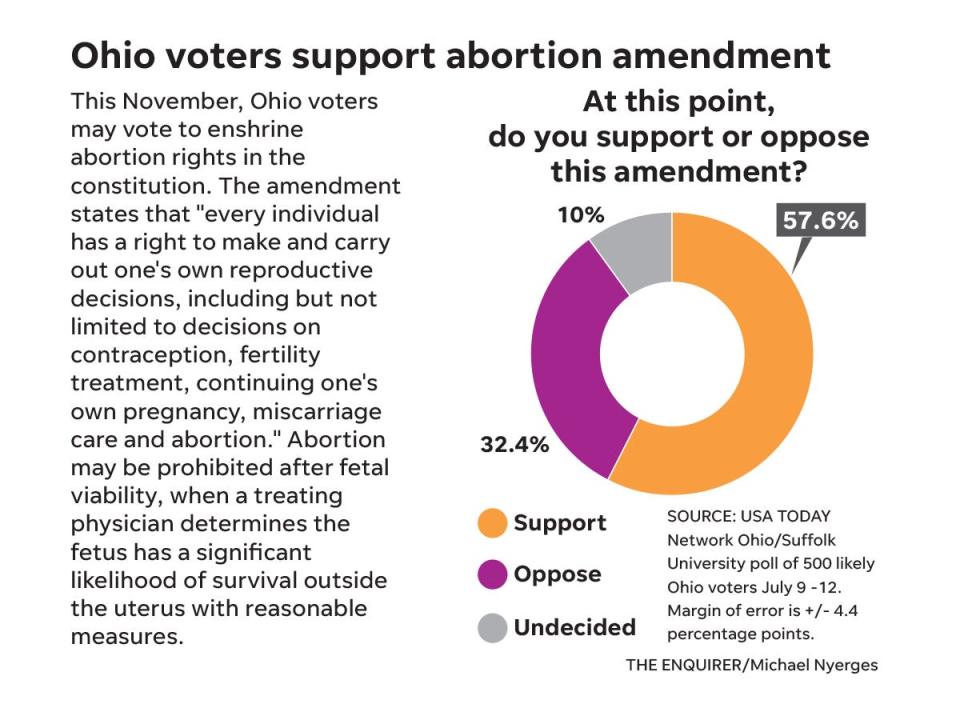What does the defeat of Issue 1 mean for the Ohio abortion measure this November?

Ohio voters issued a temporary reprieve to abortion-rights supporters on Tuesday when they rejected a proposal to make it harder to amend the state constitution.
But an expensive, nasty fight over abortion access in Ohio is only beginning.
Fifty-seven percent of voters said no to Issue 1 with over 3 million votes cast, according to unofficial results. If passed, the measure would have required 60% of voters to enact new amendments − instead of a simple majority − and changed the signature-gathering process for citizen amendments.
Ohio special election: See results from Tuesday's election on Issue 1
Tuesday's election was aimed squarely at defeating the abortion rights measure in November. GOP politicians said as much.
“This is 100% about keeping a radical pro-abortion amendment out of our constitution," Secretary of State Frank LaRose said during a Lincoln Day dinner in May. "The left wants to jam it in there this coming November."

Rep. Brian Stewart, R-Ashville, wrote in a letter to fellow GOP lawmakers last year: “After decades of Republicans’ work to make Ohio a pro-life state, the Left intends to write abortion on demand into Ohio’s Constitution. If they succeed, all the work we accomplished by multiple Republican majorities will be undone…”
The 60% threshold was strategic as well. In 2022, Michigan approved an abortion rights measure with 56.7% of the vote. Recent polling in Ohio suggests nearly 58% of voters support the reproductive rights proposal.
“It might get 50% or 51% or 52%,” Ohio Senate President Matt Huffman, R-Lima, told 610 WTVN about the abortion rights measure. “I don't think it'll get 60%."
But in the end, Ohioans rejected Republicans' attempt to change the rules for constitutional amendments.
No easy victory
Issue 1's defeat is good news for backers of the abortion rights measure, but it doesn’t assure an easy victory in November.
Ohio is the only state voting on abortion rights this year, making it the epicenter of the fight over reproductive rights just over a year after the U.S. Supreme Court overturned Roe v. Wade.
"Now, Ohioans will turn their focus to rejecting extremism and government control to ensure families have the freedom to make decisions that are best for them," said Rhiannon Carnes, spokeswoman for Ohioans United for Reproductive Rights. "Ohioans believe that abortion is a personal, private decision that should be up to them and their families without government meddling in their business."
Tens of millions will be spent on both sides of this political battle, including out-of-state money and secretive dark money. Supporters of the amendment estimate they will spend about $35 million on their campaign; opponents haven’t thrown out a number. Both groups were also active in the campaign for and against Issue 1.
Abortion-rights advocates are currently 6-0 since the U.S. Supreme Court sent decisions about abortion access back to the states in June 2022. Voters in Michigan, California and Vermont approved measures to protect abortion access while voters in Kentucky, Kansas and Montana rejected stricter abortion restrictions.
The ads will be pointed and personal. Opponents of the measure have already focused on parental rights and anti-transgender advertising to paint the proposal as too extreme for Ohioans. They are targeting not only people who oppose abortion access but those who might back it under certain circumstances.
Proponents must convince Ohioans that this proposal is measured and tailored to a Midwest voting bloc largely uncomfortable with abortions later in pregnancy.
Support for abortion rights doesn’t break down perfectly along political party lines and often exists on a spectrum with voters backing abortions at a set point in pregnancy or under certain circumstances.
Statewide, nearly 58% of Ohio voters said they would back the abortion rights amendment, including 81% of Democrats and 32% of Republicans, according to a recent USA TODAY Network Ohio/Suffolk University poll.

Poll: 58% of Ohio voters back proposal to enshrine abortion access in constitution
What would the abortion amendment do?
The proposed amendment would protect access to abortion and other reproductive decisions through viability, which is when a doctor determines a fetus can survive outside the uterus with reasonable measures. That is typically 23 to 24 weeks into pregnancy. Abortions could be performed after that point to save the patient’s life or health.
That stands in contrast to the slew of abortion bans and restrictions that Ohio’s GOP-controlled Legislature has passed over the past decade. The most restrictive was a ban on doctors performing abortions after fetal cardiac activity was detected, about six weeks after a woman’s last period.
That 2019 law was in effect for 82 days following the U.S. Supreme Court’s ruling in 2022 sending abortion decisions back to the states. Fewer patients had abortions in Ohio during that two-and-a-half-month period; about 400 traveled out-of-state to have an abortion.
That law is now on hold as the Ohio Supreme Court − which is currently dominated by Republicans − reviews some aspects of the case. It’s not clear when the justices will issue a decision.
"I think the law is sound," Ohio Right to Life President Mike Gonidakis said. "I think the Ohio Supreme Court will rule in our favor, ultimately. That may be before November or after November, but we've got to win first in November."

In the meantime, Republican lawmakers have not passed anything to either clarify that 2019 law or eliminate abortion entirely. Gov. Mike DeWine encouraged lawmakers to look at whether that law, which he signed, was "sustainable."
It remains to be seen whether that's on the Legislature's priority list this fall. Senate Republicans have discussed changes that would clarify when doctors can perform abortions to save the mother's life. But Huffman, speaking to reporters on Tuesday, said he wants DeWine to publicly outline what policies he would support and sign into law.
The Senate president said he's also not sure what the House Republican majority, led by Speaker Jason Stephens, R-Kitts Hill, can accomplish. GOP lawmakers have been divided in that chamber since a fight over the speaker's gavel earlier this year.
"I'm not sure what the ability of the speaker is to pass any pro-life legislation in the House right now," Huffman said. "Because as many of you know, there's discord − let's put it that way."
Jessie Balmert and Haley BeMiller are reporters for the USA TODAY Network Ohio Bureau, which serves the Columbus Dispatch, Cincinnati Enquirer, Akron Beacon Journal and 18 other affiliated news organizations across Ohio.
This article originally appeared on The Columbus Dispatch: What Ohio Issue 1 results mean for November abortion amendment

